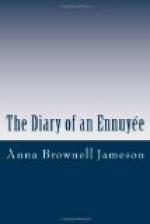* * * * *
11.—A party of four, including L** and myself, ascended the dome of St. Peter’s; and even mounted into the gilt ball. It was a most fatiguing expedition, and one I have since repented. I gained, however, a more perfect, and a more sublime idea of the architectural wonders of St. Peter’s, than I had before; and I was equally pleased and surprised by the exquisite neatness and cleanliness of every part of the building. We drove from St. Peter’s to the church of St. Onofrio, to visit the tomb of Tasso. A plain slab marks the spot, which requires nothing but his name to distinguish it. “After life’s fitful fever he sleeps well.” The poet Guidi lies in a little chapel close by; and his effigy is so placed that the eyes appear fixed upon the tomb of Tasso.
In the church of Santa Maria Trastevere (which is held in peculiar reverence by the Tresteverini), there is nothing remarkable, except that like many others in Rome, it is rich in the spoils of antique splendour: afterwards to the palazzo Farneze and the Farnesina, to see the frescos of Raffaelle, Giulio Romano, and the Caraccis, which have long been rendered familiar to me in copies and engravings.
12.—I did penance at home for the fatigue of the day before, and to-day (the 13th) I took a delightful drive of several hours attended only by Saccia. Having examined at different times, and in detail, most of the interesting objects within the compass of the ancient city, I wished to generalize what I had seen, by a kind of survey of the whole. For this purpose, making the Capitol a central point, I drove first slowly through the Forum, and made the circuit of the Palatine Hill, then by the arch of Janus (which by a late decision of the antiquarians, has no more to do with Janus than with Jupiter), and the temple of Vesta, back again over the site of the Circus Maximus, between the Palatine and the Aventine (the scene of the Rape of the Sabines), to the baths of Caracalla, where I spent an hour, musing, sketching, and poetizing; thence to the church of San Stefano Rotundo, once a temple dedicated to Claudius by Agrippina; over the Celian Hill, covered with masses of ruins, to the church of St. John and St. Paul, a small but beautiful edifice; then to the neighbouring church of San Gregorio, from the steps of which there is such a noble view. Thence I returned by the arch of Constantine, and the Coliseum, which frowned on me in black masses through the soft but deepening twilight, through the street now called the Suburra, but formerly the Via Scelerata, where Tullia trampled over the dead body of her father, and so over the Quirinal home.
My excursion was altogether delightful, and gave me the most magnificent, and I had almost said, the most bewildering ideas of the grandeur and extent of ancient Rome. Every step was classic ground: illustrious names, and splendid recollections crowded upon the fancy—




